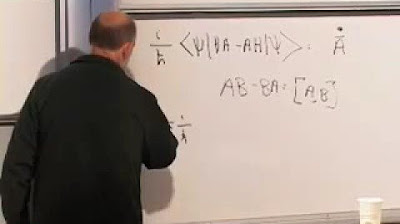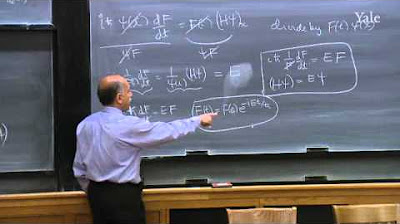L1.1 General problem. Non-degenerate perturbation theory
TLDRThe video script is a lecture on quantum mechanics, specifically focusing on the application of quantum mechanics to understand complex systems. The professor introduces the concept of a Hamiltonian, a function used to describe the total energy of a system, and discusses how it can be used to study systems more complex than previously understood, such as the simple harmonic oscillator and the hydrogen atom. The lecture then delves into the idea of a perturbation, a small change to a system's Hamiltonian that can lead to significant effects. The use of a parameter, lambda, is introduced to facilitate the understanding of these effects, allowing for a family of Hamiltonians that vary with lambda. The professor outlines the goal of understanding how energy states and eigenstates change as the perturbation is applied. The lecture concludes with an introduction to non-degenerate perturbation theory, which is used to analyze how a single state changes under perturbation, and sets the stage for further exploration into degenerate perturbation theory for systems with multiple states at the same energy level.
Takeaways
- 📚 The course 8.06 focuses on the applications of quantum mechanics to understand complex systems, building upon the foundation of simpler systems like the harmonic oscillator and the hydrogen atom.
- 🔍 Real-life systems are often more complicated than those studied in previous courses, but many can be approximated as a known Hamiltonian plus an extra term, which introduces complexity.
- ⚙️ The simple harmonic oscillator serves as a model system where the potential near its minimum is quadratic, and higher order terms like cubic or quartic introduce anharmonicity.
- 🧲 External fields such as magnetic and electric fields can be used to perturb systems like the hydrogen atom, offering insights into energy level changes.
- 🤝 Van der Waals forces exemplify how even simple systems like hydrogen can exhibit complex behavior due to induced dipole moments between neutral atoms.
- 🚀 The Hamiltonian of interest is often expressed as H_0 (the known, simple Hamiltonian) plus ΔH (the perturbation), which is a small modification to H_0.
- 🎛️ Lambda (λ) is introduced as a parameter to interpolate between the simple system (λ=0) and the full, perturbed system (λ=1), allowing for a systematic study of the effects of the perturbation.
- 📈 As λ increases from 0 to 1, the energy eigenstates and eigenvalues of the system will change, potentially leading to phenomena like level splitting in degenerate states.
- 🔑 Non-degenerate perturbation theory is used to analyze states that do not have degeneracy, providing techniques to understand how states and their energies change with the perturbation.
- 🔗 Degenerate perturbation theory addresses the more complex situation where multiple states have the same energy and thus must be treated differently when a perturbation is applied.
- 🧬 The process involves finding the new states and energies as λ increases, which requires solving the perturbed Schrödinger equation under specific conditions, using a perturbative series expansion.
Q & A
What is the main focus of the course 8.06?
-The main focus of the course 8.06 is the application of quantum mechanics to understand complex systems, which are often more complicated than those studied in previous courses.
What are some examples of simple Hamiltonian systems that have been well understood in previous courses?
-Examples of simple Hamiltonian systems include the simple harmonic oscillator and the hydrogen atom, where students have solved for the Hamiltonian, found eigenstates, and understood the energy spectrum.
Why are real-life systems often more complicated than the simple Hamiltonian systems studied in previous courses?
-Real-life systems are more complicated because they often include additional terms or effects that make them deviate slightly from the simple Hamiltonian systems, such as the inclusion of perturbations like magnetic or electric fields.
What is the role of the parameter lambda in the context of this lecture?
-Lambda is a unit-free parameter that belongs to the interval 0 to 1. It is used to define a family of Hamiltonians that depend on lambda, allowing for a continuous transition from the original Hamiltonian to the perturbed Hamiltonian.
What is meant by 'non-degenerate perturbation theory'?
-Non-degenerate perturbation theory refers to the study of how a non-degenerate state (a state with no other states of the same energy) changes in energy and state as a perturbation is turned on, starting from the original Hamiltonian.
How does the concept of degeneracy relate to the energy levels of a system?
-Degeneracy occurs when there are multiple states with the same energy. In the context of the lecture, the perturbation might either maintain or split this degeneracy, leading to different energy levels for what were initially degenerate states.
What is the significance of the perturbative series expansion in solving the problem?
-The perturbative series expansion allows for a systematic approach to solving the problem by breaking down the solution into a series of corrections that are proportional to powers of lambda, making it easier to calculate the changes in energy and state due to the perturbation.
How does the process of turning on the perturbation (changing lambda from 0 to 1) affect the eigenstates and energies of the system?
-As lambda changes from 0 to 1, the eigenstates and energies of the system undergo continuous changes. Initially, they were eigenstates of the unperturbed Hamiltonian, but as the perturbation is turned on, they evolve into new eigenstates with modified energies.
What is the assumption made when using perturbative series expansion to solve for the state and energy of the system?
-The key assumption is that there exists a solution in the form of a perturbative series expansion, where the state and energy can be expressed as a sum of terms proportional to different powers of lambda, with the coefficients being lambda-independent and needing to be calculated.
What is the difference between the Hamiltonian H0 and the total Hamiltonian H?
-The Hamiltonian H0 represents the well-known, unperturbed system, while the total Hamiltonian H is the sum of H0 and an extra piece, delta H, which represents the perturbation or the variation from the original system.
Why is it important to consider the Hermitian nature of Hamiltonians?
-Hamiltonians must be Hermitian to ensure that the eigenvalues (energies) are real and that the eigenstates form an orthonormal basis, which is crucial for the mathematical description and physical interpretation of quantum systems.
Outlines
📚 Introduction to Quantum Mechanics Applications
The first paragraph introduces the course 8.06, focusing on the application of quantum mechanics to understand complex systems. It contrasts the simplicity of previously studied systems, such as the harmonic oscillator and the hydrogen atom, with the more complicated systems encountered in practical scenarios. The lecture emphasizes that while these systems are more complex, they can often be approximated by a known Hamiltonian plus a small perturbation, represented as delta H. This approach allows for the study of systems like diatomic molecules, the hydrogen atom under the influence of magnetic and electric fields, and the effects of Van der Waals forces.
🔍 Hermitian Hamiltonians and the Lambda Parameter
The second paragraph delves into the mathematical framework of the problem, stressing the importance of Hermitian Hamiltonians. It introduces a parameter lambda, which is unit-free and varies between 0 and 1, to define a family of Hamiltonians. This parameter is crucial for solving equations and offers physical insight, as it can represent the original Hamiltonian when set to 0 or the total Hamiltonian when set to 1. The paragraph also discusses the concept of a small perturbation and how lambda helps in managing this by scaling the perturbation's impact.
🌟 Understanding Energy Spectra and State Changes
The third paragraph discusses the energy spectra of the unperturbed Hamiltonian H0 and the impact of turning on a perturbation, represented by lambda. It covers the concept of degenerate and non-degenerate states and the expectation that eigenstates and energies will change continuously as lambda varies from 0 to 1. The paragraph also explores the potential splitting of degenerate states due to the perturbation and the need for different perturbation theories to address non-degenerate and degenerate states.
📈 Non-Degenerate Perturbation Theory
The fourth paragraph focuses on non-degenerate perturbation theory, which is applicable when the Hamiltonian's eigenstates are non-degenerate. It explains that the eigenstates of the unperturbed Hamiltonian H0 are orthonormal and ordered by energy levels. The goal is to determine how the energy and state of a given non-degenerate eigenstate change as the perturbation is introduced. The paragraph outlines the process of solving for the new state and energy as a function of lambda, starting from the known unperturbed state and energy.
🔬 Perturbative Series Expansion and Solving the System
The fifth and final paragraph introduces the method of solving the perturbed system using a perturbative series expansion. It postulates that the state and energy can be expressed as a series in lambda, with the original state and energy as the zeroth-order terms. The paragraph outlines the assumption that the corrections to the state and energy can be found by solving the perturbed Hamiltonian's equation under the given conditions. The unknowns in this process are the higher-order corrections to the state and energy, which are lambda-independent and must be calculated.
Mindmap
Keywords
💡Quantum Mechanics
💡Hamiltonian
💡Eigenstates
💡Perturbation Theory
💡Degeneracy
💡Harmonic Oscillator
💡Hydrogen Atom
💡Van der Waals Forces
💡Parameter Lambda
💡Non-Degenerate Perturbation Theory
💡Degenerate Perturbation Theory
Highlights
Introduction to 8.06 course focusing on the application of quantum mechanics to understand complex systems.
Review of foundational knowledge including the simple harmonic oscillator and the hydrogen atom Hamiltonian.
Discussion on the practicality of exact systems versus the more complex systems encountered in real-life scenarios.
Introducing the concept of a Hamiltonian that can be broken down into a simple Hamiltonian plus an extra term.
Explaining how the simple harmonic oscillator can be used as a model for more complex systems with a potential.
Describing experimental observations on the hydrogen atom under the influence of magnetic and electric fields.
The importance of Van der Waals forces in the interaction between neutral atoms.
The use of a parameter lambda to interpolate between the known Hamiltonian and the total Hamiltonian of the system.
Lambda as a unit-free parameter ranging from 0 to 1, allowing for a family of Hamiltonians.
The perturbative approach to solving the equations by introducing lambda and its physical significance.
Criteria for considering a Hamiltonian 'small' compared to another and its implications for perturbation theory.
The assumption that the perturbation can be treated as a small correction for sufficiently small lambda values.
Visualization of how energy levels and eigenstates change as the perturbation is turned on, using a plot.
Differentiating between non-degenerate and degenerate states and their treatment in perturbation theory.
The phenomenon of degeneracy splitting due to perturbation and its significance.
The need for sophisticated degenerate perturbation theory for systems with complex energy level interactions.
Starting with non-degenerate perturbation theory as a simpler case before moving to more complex scenarios.
Assumption of an orthonormal basis of states for a Hermitian Hamiltonian and its role in the perturbative series expansion.
The hypothesis of a perturbative series expansion for the state and energy as lambda changes from 0 to 1.
Transcripts
Browse More Related Video

Lecture 9 | Quantum Entanglements, Part 1 (Stanford)

The Theory that Solves "Unsolvable" Quantum Physics Problems - Perturbation Theory

Advanced Quantum Mechanics Lecture 3

24. Quantum Mechanics VI: Time-dependent Schrödinger Equation

Lecture 5 | The Theoretical Minimum

Lecture 4 | The Theoretical Minimum
5.0 / 5 (0 votes)
Thanks for rating: